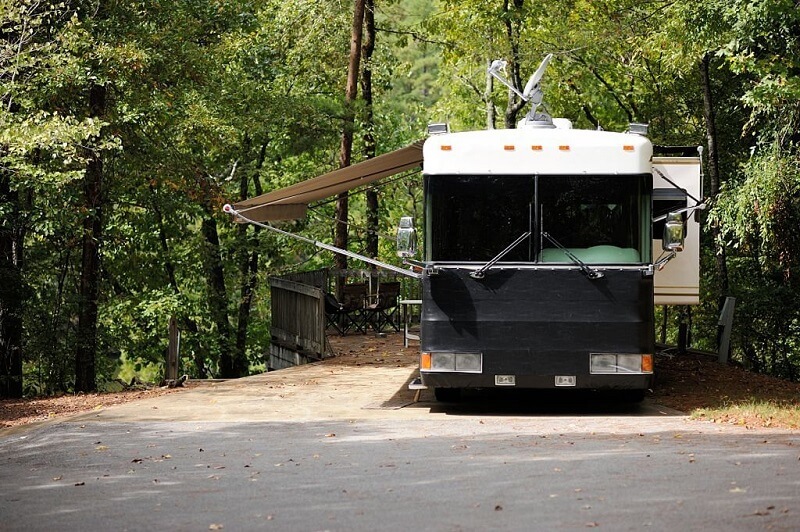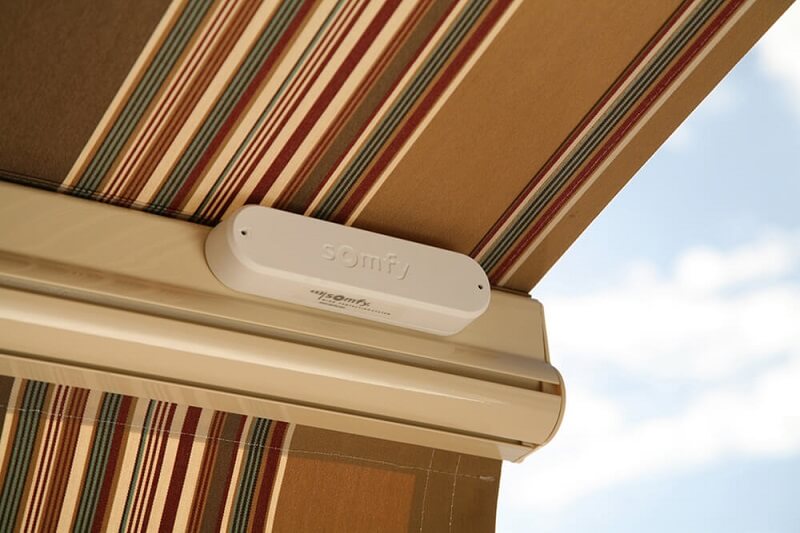Awnings provide a great deal of protection from the sun and weather while you’re camping, but How Much Wind Can an RV Awning Take? If you’re worried about whether your awning will hold up in high winds, fear not!
Most awnings can handle winds up to around 30 or 40 miles per hour. Of course, if you’re in an area with particularly high winds, it’s always best to err on the side of caution and put your awning away. But for the majority of campers, an awning should be more than enough to keep them safe from bad weather.
What is an RV awning?
RV awnings are a great addition to any RV, providing shade and protection from the elements. There are a variety of RV awnings available on the market, from basic models that provide basic coverage to more sophisticated models that offer extended coverage and protection.
RV awnings are typically made from fabric or metal, and they can be either manually or electrically operated. RV awnings can be a great way to extend your living space and enjoy the outdoors, and they can also help to protect your RV from the elements.
When choosing an RV awning, it is important to consider the size of your RV, the climate in which you will be using it, and your budget.
How much wind can an RV awning take?
RV awnings are designed to provide shade and protection from the sun and rain. However, they can also be vulnerable to strong winds. Most RV awnings are made from aluminum or vinyl, which are both light and durable materials.
However, in strong winds, RV awnings can be damaged or even torn from their mountings. To avoid damage, it is important to know how much wind your RV awning can take.

Most RV awnings are rated for winds up to 35 mph. In winds above 35 mph, it is advisable to take down the awning and secure it to avoid damage. By taking a few simple precautions, you can help ensure that your RV awning lasts for years to come.
In the table below, you will find further details corresponding to the wind type, strength, and speed.
| Beaufort Scale | Wind Strength | Speed (km/h) | Speed (mph) |
| Light to Moderate Breeze | 0-4 | 1-29 | 1-18 |
| Fresh Breeze | 5 | 30-39 | 19-24 |
| Strong Breeze | 6 | 40-49 | 25-31 |
| Moderate to Strong Gale | 7-9 | 50-88 | 32-54 |
| Whole Gale | 10 | 89-102 | 55-63 |
How to secure your RV awning in high winds
To secure your Rv from high winds, you will need the following items:
1. Checking the fit:
Make sure that your RV awning is the right size for your RV. An awning that is too large or too small can be more susceptible to damage in high winds.
2. Checking the condition:
Inspect your RV awning regularly for signs of wear and tear. Any rips, holes, or tears should be repaired as soon as possible to avoid further damage.
3. Checking the mounting:
The mounting of your RV awning is critical to its stability in high winds. Make sure that the awning is mounted securely and that all of the hardware is tight and in good condition.
4. Securing the awning:
In high winds, it is important to secure your RV awning to prevent damage. There are a variety of ways to do this, including tying the awning down with ropes or straps or using weights to keep the awning in place.
5. Adjusting the angle:
The angle of your RV awning can also affect its stability in high winds. In general, it is best to keep the awning at a slightly angled position to provide more resistance to the wind.
6. Using additional weight:
Adding additional weight to the base of your RV awning can help to keep it in place in high winds. This can be done by filling water jugs or sandbags with water or sand and placing them at the base of the awning.
7. Use guy lines:
Guy lines are ropes or cables that are attached to the awning and staked into the ground. These lines help to provide additional support and stability to the awning in high winds.
8. Inspecting the awning regularly:
Inspecting your RV awning on a regular basis can help you to spot any potential problems before they become serious. This includes checking for signs of wear and tear, as well as making sure that all of the hardware is tight and in good condition. By taking these simple steps, you can help to ensure that your RV awning lasts for years to come.
9. Taking down your RV awning in high winds:
If you are expecting high winds, it is best to take down your RV awning. This will help to avoid damage to the awning and keep it from being torn from its mounting. To take down your RV awning, start by loosening the fabric and rolling it up.
>> Read More: RV Awning Will Not Roll Out-How to Fix
Types of RV awnings and their wind resistance
RV awnings come in a variety of shapes, sizes, and materials. The most common type of RV awning is the pop-up camper awning. These awnings are easy to set up and take down, and they offer good protection from the sun and rain. However, they are not very wind-resistant, so they should be used with caution in windy weather.
Another type of RV awning is the full-size awning. These awnings provide more coverage than pop-up camper awnings, and they are more wind-resistant. However, they can be more difficult to set up and take down.
Aluminum awnings
Aluminum awnings are one of the most popular types of RV awnings. They are lightweight and durable, making them a good choice for use in high winds. However, aluminum awnings can be more expensive than other types of awnings.
Vinyl awnings
Vinyl awnings are another popular type of RV awning. They are also lightweight and durable, making them a good choice for use in high winds. However, like aluminum awnings, vinyl awnings can be more expensive than other types of awnings.
Fabric awnings
Fabric awnings are the most common type of RV awning. They are typically made from canvas or another type of fabric. Fabric awnings are less expensive than other types of awnings, but they are not as durable and can be more susceptible to damage in high winds.
Fiberglass awnings
Fiberglass awnings are another type of RV awning. They are typically made from a combination of fiberglass and resin. Fiberglass awnings are less expensive than other types of awnings, but they are not as durable and can be more susceptible to damage in high winds.
No matter what type of RV awning you choose, be sure to choose one that will meet your needs in terms of wind resistance.
Learn more about Wind Resistance Classification
In this section, our expert will give their opinion about Wind Resistance Classification by a visual table.
The wind resistance rating is categorized under different classes. Each classification is based on wind mileage and wind strength.
It also indicates whether an awning can or cannot be used when the wind resistance rating falls under that class.
| Awning Wind Resistance Class | Wind Mileage | Wind Strength | Measures to protect the awning |
| Class 0 | 0-12 mph (0-19 km/h) | 3 | Do not use it in windy conditions. |
| Class 1 | 13-17 mph (20-27 km/h) | 4 | It can be used till the wind starts to lift dust. |
| Class 2 | 18-23 mph (28-37 km/h) | 5 | It can be used till the small trees begin to sway. |
| Class 3 | 24-30 mph (38-48 km/h) | 6 | It can be used till the larger tree branches begin to move. |
Tips for keeping your RV awning in good condition despite strong winds
Store your RV awning properly when not in use
When you are not using your RV awning, it is important to store it properly to avoid damage. This includes making sure that the awning is clean and dry before storing it, as well as keeping it out of direct sunlight.
Inspect your RV awning regularly
Inspecting your RV awning on a regular basis can help you to spot any potential problems before they become serious. This includes checking for signs of wear and tear, as well as making sure that all of the hardware is tight and in good condition.
Use additional weight
Adding additional weight to the base of your RV awning can help to keep it in place in high winds. This can be done by filling water jugs or sandbags with water or sand and placing them at the base of the awning.
By following these simple tips, you can help to ensure that your RV awning lasts for years to come.
Benefits of a Wind Sensor in Awnings

RV awnings are a great addition to any RV, providing shade and protection from the elements. However, they can also be quite expensive, and it’s important to make sure that they’re properly installed and maintained.
One way to do this is to install a wind sensor on your RV awning. A wind sensor can help to prevent damage to your awning by automatically retracting it when strong winds are detected. This can save you both money and hassle in the long run, as you won’t have to worry about repairing or replacing your awning due to wind damage.
In addition, a wind sensor can also help to extend the life of your RV awning by preventing it from being overexposed to the sun and other harsh weather conditions. So if you’re looking for a way to protect your RV awning, consider investing in a wind sensor.
>> Editors Pick, Best Wind Sensor for Rv Awnings
Frequently Asked Questions:
Q: How much wind can an RV awning take?
A: The amount of wind that an RV awning can take depends on the type of awning, as well as the condition of the awning. In general, aluminum and vinyl awnings are more resistant to high winds than fabric awnings.
Q: What is the best way to take down an RV awning in high winds?
A: The best way to take down an RV awning in high winds is to start by loosening the fabric and rolling it up. By doing this, you can help to avoid damage to the awning and keep it from being torn from its mounting.
Q: How can I keep my RV awning in good condition despite strong winds?
A: There are a few things that you can do to help keep your RV awning in good condition despite strong winds. This includes storing the awning properly when not in use, inspecting it regularly, and using guy lines or additional weight to help keep it in place.
Conclusion
While high winds can be a problem for RV awnings, there are a few things that you can do to help prevent damage. By following the tips above, you can help to ensure that your RV awning lasts for years to come.

Hi I’m Joiel Borid Creators of RV Outsider. Wild Life’s first camping was started when I’m 8 years old, at the Home Front Yard. Moto of RV Outsider shares my experience, expertise, and knowledge that I learned, and apprises about my next journey. So stay tuned with RV Outsider.
